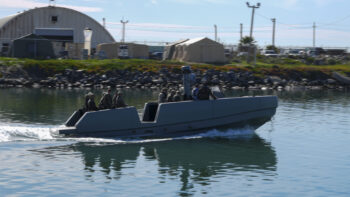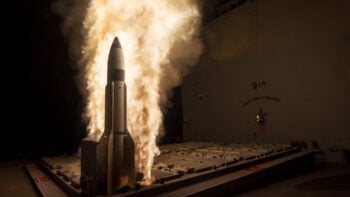
UPDATED: Adds Pratt & Whitney Responses To Bogdan; Adds Lockheed Statement Correction (April 18 at 10:55 am)
CRYSTAL CITY: Pratt & Whitney got a public drubbing from the sharp-tongued head of the F-35 fighter program, Lt. Gen. Christopher Bogdan, when the Pentagon released a new cost estimate for the military’s biggest weapons program.
“Pratt’s not meeting their commitment, it’s as simple as that,” he told reporters this afternoon at the Joint Program Office’s headquarters here. “They told us years ago that the engine was going to come down at a certain rate in terms of price and they haven’t met it. Not good. Not good at all.”
But the three-star general’s harsh words for the jet engine maker — undoubtedly designed in part to pressure Pratt in ongoing negotiations for the next two lots of F135 engines — were his one negative note in an otherwise upbeat briefing on the F-35’s Selected Acquisition Report (SAR) for 2013. The question is whether the good news numbers actually hold up.
But a Hill aide who reviewed the numbers for us was quite skeptical.
The GAO estimates that, for aircraft programs, investment costs are roughly 30 percent of an aircraft’s total life-cycle costs, the aide notes. The remaining 70 remaining of costs are for operations, maintenance, sustainment and disposal.
“So using rough math, add up all the R&D and procurement costs planned for F-35 and multiply by three,” the staffer said. “That would give you a total cost of $971 billion (in 2012 dollars). That’s well in excess of the SAR estimate, which relies on more optimistic figures for operations and sustainment. “Given the reliability and availability metrics, they’re a long way from realizing those,” said the staffer. “The life cycle cost is likely to be much higher.”
The Pentagon’s independent office for Cost Assessment and Program Evaluation (CAPE) dropped its estimate for the total cost of the massive F-35 program over more than half a century by 2 percent, from $936 billion in its previous report to $921 billion in the SAR released today. (That’s in 2012 dollars; costs in future-year dollars dropped from $1.5 trillion to $1.4).
For its part, F-35 maker Lockheed Martin, was, well, “very pleased with the $19.2 (Corrected Rein’s error at his request) $15.1 billion reduction in the overall cost of the program in fiscal year 2012 dollars…” Keenly aware of the counting pressure from senior Pentagon leaders, Congress and allied partners to bring costs down even more, Lockheed spokesman Mike Rein kept going. “While this is a significant reduction, we share Secretary Kendall’s view that we will achieve more savings in both the Acquisition and Operations & Sustainment areas. We are confident that as the program continues to grow and mature costs will continue to decrease. This is the second year in a row an overall program cost reduction was noted by the SAR.”
But, the dip in the life costs masks a slight increase in the estimated cost to develop, build, and field the fifth-generation fighter. They rose 1.4 percent — $4.5 billion — from $319.4 billion to $323.5 billion (in 2012 dollars). That increase is driven less by Pratt & Whitney’s problems than by rising labor costs, which are in part a result of the global economic recovery. Also, schedule delays, caused not by the program’s internal troubles but by budget cuts in both the US and foreign partners, also play a role.
What cancels out that increased procurement cost — in theory — is a 12 percent, $80 billion drop in the estimated “operating and support” costs to keep the planes flying once they’re bought. (From $679 billion to $599 billion, again in 2012 dollars). Those savings come in large part from CAPE’s acceptance of lower Navy and Marine Corps figures for how much fuel they’re going to burn per plane, which has been a particularly contentious issue for the short-take off and vertical landing (STOVL) mode of the Marine’s F-35B jump jet variant, which uses enormous amounts of fuels when it hovers, lands or takes off using its lift fan.
The fundamental problem with these O&S figures is they attempt to cover the entire life of the program until the projected retirement of the last F-35 in 2065, half a century from now. Over such a length of time, you can get wildly different estimates from slightly different assumptions about such things as international exchange rates — let alone actual improvements or shortfalls in the aircraft itself.
But Bogdan, in contrast with the congressional aide we quoted above, thinks the CAPE was too pessimistic about the O&S costs. Why? CAPE bases its reliability estimates on older data, from when the F-35 fleet had only flown a total of 8,500 hours. The fleet recently exceeded 15,000 hours and costs are coming down because the newer aircraft incorporate fixes to expensive problems of the earlier ones, Bogdan said. The program also has new figures for the cost of depot maintenance, the ratio of contractor to government personnel required, and Air Force cost per flight hour, Bogdan said, which will all drive lower O&S costs.
Bogdan admitted there are plenty of unknowns left. “We’re only about 55 percent done with the flight test program,” he told reporters today. (The Pentagon’s top procurement official once called this concurrency of testing and production “acquisition malpractice“). That means there are undoubtedly more problems to find and more fixes to make.
Just recently, for example, the program had to redesign the nitrogen injection system that keeps the gas tanks from exploding when the plane is struck by gunfire or lightning. The next lot of aircraft to be built, LRIP 7, will have a more powerful nitrogen system, but the ones already built and currently under construction do not, he said: “Some day, they’re going to have to come back and get that retrofitted so they can fly in lightning.”
Then there’s the Pratt & Whitney problem. The company says their costs simply reflect the lower-than-planned production rate, he said: “The answer they have given me [is], ‘this is all tied to economies of scale, Gen. Bodgan, when you buy more engines the price will come down.’ [But] that’s only part of the answer.”
Pratt & Whitney has lost jet engine business on both the commercial and military sides, Bogdan said, so “they’re spreading their overhead costs” in ways that bump up costs to the government. “I don’t like that.” (The termination of the F-22 line by former Defense Secretary Robert meant an enormous reduction in engine purchases from Pratt, for example. And those cuts are just beginning to be felt.)
UPDATE Begins: “We have invested more than $65 million into ‘War on Cost’ activities and reduced the cost of the F135 engine by more than 40 percent. We are pursuing cost reductions in every aspect of the program, including supply chain, configuration changes, process improvements, and overhead. The key factor in driving down cost, however, is to increase the ramp rate. “We have invested more than $65 million into ‘War on Cost’ activities and reduced the cost of the F135 engine by more than 40 percent,” the engine maker says in an official statement . “The key factor in driving down cost, however, is to increase the ramp rate.”
Pratt has a point when it argues that budget cuts both in the US and abroad have slowed the pace at which planes are being built and bought, which increases the price of each. (While the SAR only accounts for US costs, foreign sales create efficiencies of scale that ultimately save America money.)
“Since the ‘War on Cost’ started in 2009, nearly 500 engines have been cut from our shop load forecast in 2013-2016 – a 25 percent reduction in our total shop load,” Matthew Bates, spokesman for Pratt’s military engines division said in an email. “Nevertheless, we continue to deliver a robust 87% cost improvement curve, and we expect to continue delivering LRIP over LRIP price reductions despite F135 volume push out.” Bottom line: Bates says Pratt plans to come to an agreement with Bogdan’s office on LRIP 7/8 by the end of the second quarter resulting in “a fair procurement.” UPDATE ENDS
The Navy now plans to buy 33 fewer aircraft in the current Future Year Defense Plan (FYDP), the Air Force to buy four, and, if Congress does not grant the president’s request for significant spending above the current sequestered budget caps, another 16 or 17 US planes are going to go away. Meanwhile Turkey, Canada, Holland, and Italy have all slowed or reduced their purchases of F-35s.
“The cumulative effect of all of that movement is about on the order of a couple of a percent in the price of each airplane,” Bogdan said. “Worst case scenario there is about 4 percent.”
Bogdan’s solution? Find more foreign customers to get back those efficiencies of scale — and he’s strikingly optimistic on that front. “None of these numbers include 40 airplanes I’m pretty sure South Korea is going to buy starting in LRIP 10. None of this includes Singapore,” he said. “[And] we’re pretty convinced Israel is not going to stop at 19 airplanes.”
If the SAR had accounted for all the likely foreign sales, said Bogdan, “[we] would have driven that acquisition cost down instead of up.”
But CAPE can’t base its estimates on deals that haven’t actually been signed. Until the hoped-for foreign sales materialize, we have to price the bird we have in the hand, not however many we estimate are in the bush.
Air Force stands up two new EW squadrons, but still short on personnel
“We have recognized in our threat analysis that we need these capabilities in our wing in order to make our three wing missions executable,” Col. Joshua Koslov said of activating two EW squadrons. “And so that’s exactly what’s driving it.”


























